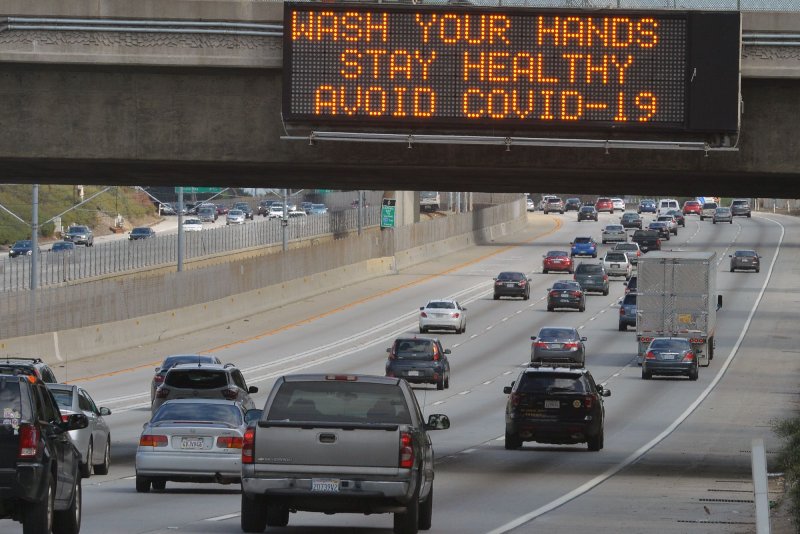A coronavirus health advisory is displayed on Interstate 105 in Los Angeles on Sunday. Photo by Jim Ruymen/UPI |
License Photo
March 16 (UPI) -- People who don't know they have the new coronavirus may be unintentionally driving the spread of it, an analysis published Monday in the journal Science suggests.
Using data from China -- where the COVID-19 outbreak originated -- epidemiologists developed a mathematical model of infectious disease spread. The model estimates nearly 80 percent of confirmed cases of the disease originated from so-called "undocumented" cases, or those who experienced mild, limited or no symptoms and went undiagnosed as a result.
The researchers believe the findings help explain the rapid global spread of the virus.
"When someone experiences mild symptoms, and most of us can relate to this, we still go about our day and send the kids to school and go to work and might have a headache or slight fever and maybe take ibuprofen and go out and go shopping and whatnot," study co-author Jeffrey Shaman, professor of environmental health at Columbia University, said at a press briefing Monday. "It is that continued contact with people that allows the transmission of many respiratory viruses."
As of Monday, there were 175,000 confirmed cases of COVID-19 worldwide, affecting 127 countries. Over the weekend, for the first time, the number of cases reported outside China eclipsed the total cases inside the nation.
The authors of the new paper -- all of whom are based outside China -- developed a mathematical model that simulates the "spatio-temporal dynamics" of infections among 375 Chinese cities. They divided COVID-19 infections into two types: confirmed, documented infected individuals with symptoms and undocumented infected individuals, with the latter based on estimates.
Researchers calculated separate rates of transmission for each of these two types based on population and the movement of people between locations.
With this approach, the authors estimated that, prior to travel restrictions implemented on Jan. 23, 86 percent of all infections in China were undocumented. This translates to the nearly 82,000 confirmed cases there likely being a fraction of the real total of cases.
According to Ira Longini Jr., a professor of biostatistics at the University of Florida, the findings suggest that one of every seven cases of COVID-19 presents with severe enough symptoms to allow for confirmed diagnosis -- because only those with severe symptoms pursue treatment.
"If you were to project that number globally, given we have 150,000 confirmed cases, we are approaching close to one million infections," said Longini, who was not part of the research team. "We could argue or dispute what the specific number is -- and might be one in 10 in some societies, versus one in five and others."
This translates to the 3,500 confirmed cases in the United States potentially being as many as 35,000 infections, Longini said.
The authors believe that, per person, the transmission rate of undocumented infections was 55 percent of documented infections. However, due to their greater numbers, undocumented infections were the infection source for 79 percent of documented cases.
"With the emergence of the novel coronavirus we wanted to identify factors that were supporting the rapid geographic spread that we observed within China as it moved between countries," Shaman said.
"Because there are many more of these undocumented cases, it's the undocumented infections that drive the spread and growth of the outbreak," Shaman noted. "The undocumented infections, which tend to be milder, are distributing the virus broadly and are contributing essentially to what they call stealth transmission of the virus because it's undetected and flying below the radar."
A health worker with the Israeli national emergency service, Magen David Adam, wears protective gear while taking swabs to test for COVID-19 at a drive-through testing center in East Jerusalem on August 26. Photo by Debbie Hill/UPI |
License Photo
















